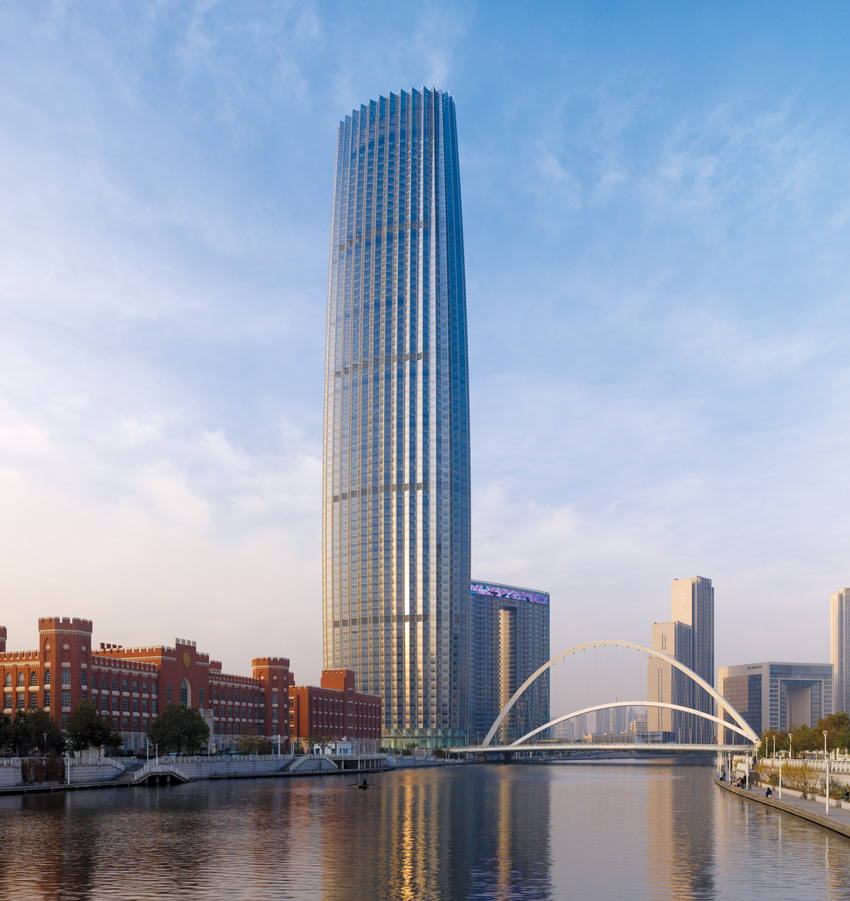The Core of the Matter
X Marks the Spot
While steel-braced core technology has advanced significantly in recent years, now providing building teams with various options, one of the most long-standing systems still in use is X-bracing.
Delivering both tension and compression on both sides, thanks to the symmetrical X-brace, the system is an efficient way to support a building’s lateral loads. While it can be applied to core, its diagonal members will obstruct the building’s views and fail to deliver sufficient stiffness to the structure, so this core approach is typically limited to lower-rise facilities with few openings.
“X-bracing is typically avoided in core framing,” confirms Eli B. Gottlieb, PE, senior principal, Thornton Tomasetti, New York City. “The X-brace layout results in gravity loads traveling through the braces in an indeterminate manner that results in additional material being required for the project. While that geometry is very efficient, for lightweight structures, it is often undesirable in the core of a tower.”
However, applying the X-bracing to the outside curtain wall—as clearly seen in the Hancock Building—is commonly done. Lending an interesting aesthetic to the exterior, keeping the views intact, and providing additional stiffness, the exterior X-brace frame has traditionally been a common choice.
At the same time, more recent steel-core innovations have opened up the range of possibilities, offering better costs, construction schedules, and more leasable square feet.
Steel Plate Shear Walls
For example, steel plate shear walls (SPSW) embrace the same concept as a braced core, only instead of a diagonal member, a steel plate is used.
“By welding a steel plate to the beams and columns, you’ve created a steel plate all made of steel. It can be as stiff as a brace, while using less materials because it’s thinner,” explains Michel Bruneau, Ph.D., PE, professor, department of civil, structural, and environmental engineering, University at Buffalo, Buffalo, New York. “It’s also thinner than the concrete walls and offers more occupiable square footage.”
With a plethora of steel plate manufacturing facilities on the market, the flat material is made in abundance. “You can prefabricate the plate and bolt it into place,” explains Sarkisian. “Stitching the columns together with the plates, even one step behind the erection of the columns, makes for a very efficiently constructed system that doesn’t require welding.”
Offering a number of advantages over conventional bracing, Gottlieb relates that SPSW are better at providing a ductile frame for seismic energy dissipation and providing a thinner profile for potentially more floor area. “For fabrication and construction, the connections are simple and clean, as the panels are rectilinear elements, ideally bolted into positions, although for higher loads, welded joints may be required.”
With thinner-plate walls, additional strength is provided from the tension-field action created by their design, according to Carter, but SPSW can also be designed as thick-plate walls, which are designed based upon plate yielding.
Offering his opinion, Mark Garland, PE, president of the Toronto-based construction management firm LCL BUILDS, explains that the performance of a steel plate shear wall is significantly enhanced if the steel plate is made thinner, and outfitted with Nelson studs, when used to function as a form for the concrete shear wall.
When furnishing SPSW, Hooper stresses the importance of making the plates as modular as possible coming from the fabrication shop. This includes minimizing or even eliminating the need for complete joint penetration welds so that these connections are minimized as much as possible on-site. “Otherwise, these welds take a lot of time and are difficult to do up in the air.”
If building teams are looking for guidance, AISC’s Design Guide 20: Steel Plate Shear Walls, authored by Bruneau and Rafael Sabelli, SE, director of seismic design, Walter P. Moore, San Francisco, is a good resource. “Anything you wish to know about SPSW is pretty much in there, including lots of research,” says Bruneau.
In addition, AISC’s Seismic Provisions for Structural Steel Buildings offers guidelines such as standard thickness for plates. “We go beyond what the specification requires, as we’re dealing with a lot of high seismic projects in California,” relates Hooper.
MKA uses the latest data on SPSW performance to help inform their designs, taking advantage of test results conducted by universities like Purdue and State University of New York Buffalo State.
While AISC is in the process of updating its seismic provisions document, that guideline won’t be available until 2017. In the meantime, Bruneau’s textbook, Ductile Design of Steel Structures, is a helpful reference with a lot of up-to-date information on SPSW, as well as other steel-braced core options.
China's Jinta Tower
For the Jinta Tower in Tianjin, China, described as the world’s tallest steel shear plate wall building at 75 stories, the building team, led by SOM, evaluated a number of options for the core before selecting a SPSW system.

Photo courtesy of SOM
As the world’s tallest steel shear wall building, the 75-story Jinta Tower in Tianjin, China, utilizes perimeter and core ductile moment-resisting frames and outrigger and belt trusses to withstand seismic and wind forces.
In particular, an all-concrete dual system with perimeter moment-resisting frames and core shear walls was ruled out because the large shear wall and column sizes would have decreased the rentable area, and consequently the project’s financial viability.
Composite concrete and steel plate shear walls were also considered, but ultimately, there was insufficient research and testing data—addressing specific features of the project—to satisfy the authorities. Meanwhile, dual steel systems with braced cores would have required as much as 20 percent to 25 percent more steel. So ultimately, SPSW proved to be the most appropriate choice.
For the very slender, uniquely shaped skyscraper, with an overall aspect ratio of close to 1:8, SPSW also delivered an efficient lateral system capable of resisting significant wind and seismic lateral loads, while keeping wind-induced lateral drifts and oscillations under acceptable limits.
Altogether, the main lateral force-resisting system consists of a frame-shear wall system with perimeter and core ductile moment-resisting frames and core SPSW linked together with outrigger and belt trusses. As for the ductile moment-resisting frames, in an American Institute of Physics (AIP) Seismic Engineering Conference white paper, “Steel Plate Shear Walls: Efficient Structural Solution for Slender High-Rise in China,” authored by Sarkisian and his SOM colleagues, the frames are described as concrete filled steel pipe composite (CFT) columns and structural steel wide-flange beams. Similarly, the SPSW are CFT columns and structural steel wide-flange beams in-filled with structural steel plates.
To ensure that the perimeter columns resist overturning, outrigger trusses are placed in the short direction of the tower plan. Meanwhile, belt trusses at the outrigger levels work to better distribute the axial loads resulting from outrigger action among the perimeter columns. Four sets of outrigger and belt trusses are positioned at the mechanical levels, and strengthened diaphragm slabs are used at the outrigger levels.
“The columns are circular, and the framing is built up with plate running two-thirds the height of the building and then changes to a braced frame,” relates Sarkisian.
As explained in the AIP conference white paper, “The building frames are designed to carry gravity loads while neglecting the contribution of the SPSW plates, which ensures that the building frames have sufficient capacity to support the gravity loads during seismic events when the plates could experience buckling due to the development of the tension-field action.”
The SPSW plates were sized to respond elastically without tension-field action or buckling from the region’s frequent earthquake loads and wind loads. In the event of a moderate earthquake, tension-field action is expected to be the primary lateral load resisting mechanism in the SPSW plates.









